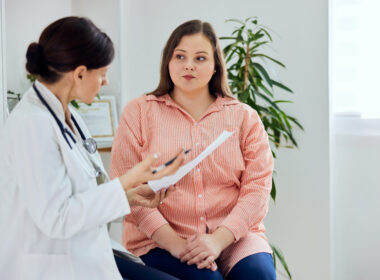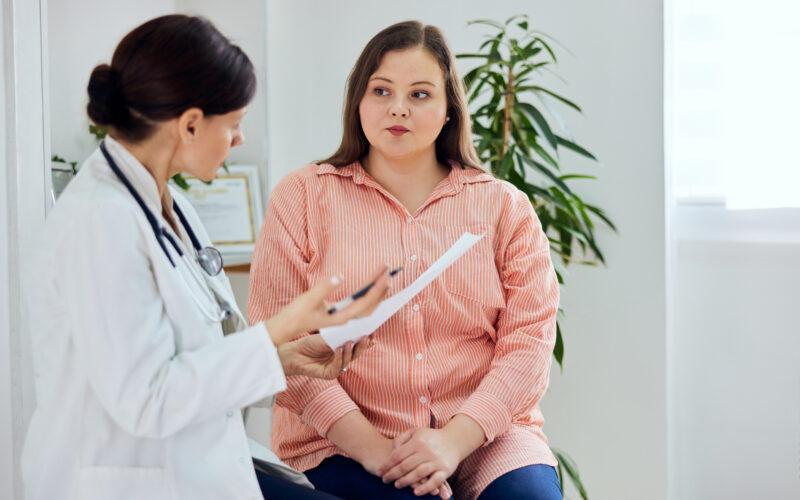Kate Downey describes period “death cramps” on her podcast, Cramped, as a pain that radiates down your back and legs, makes standing difficult, and fills your body with so much pain (actually, prostaglandins) that you vomit. You emerge sweating, shaking, wondering what just happened, with your plans for the day erased.
I’ve had those kinds of periods before, and if you have too, I’m so sorry. Perhaps you have your own “death cramps” story, or perhaps you’ve experienced a different, equally disturbing menstrual-related disorder like SOP, PMS, or TDPM. Or perhaps you’ve experienced hardship from a different health concern that disproportionately affects women. For example, 78% of people with an enfermedad autoinmune are women [1]. Furthermore, women are twice as likely to experience salud mental issues like anxiety, depression, and PTSD. And while each of the diseases that women face come with their own distinct brand of suffering, part of that suffering stems from a lack of research and understanding that stands in the way of receiving proper care.
While each of the diseases that women face come with their own distinct brand of suffering, part of that suffering stems from a lack of research and understanding that stands in the way of receiving proper care.
In Kate Downey’s case, the only long-term treatment offered for her debilitating dysmenorrhea (the clinical term for painful periods) was hormonal birth control, which decreased the frequency of her pain, but did not make the problem go away. Without a diagnosis, she was stuck for years until she decided to find answers–no matter the coste. And while painful periods and endometriosis don’t always go hand-in-hand, it probably doesn’t come as a big surprise that Kate Downey’s journey led to an cirugía de escisión to remove the endometriosis lesions that had been causing so much suffering. And while Downey finally received a solution after decades of pain, she finds herself exploring new questions: why did she have to suffer for so long without treatment, and how has this shaped her as a person?
And since Downey’s story of decades of undiagnosed and untreated pain isn’t unique, what are our own answers to these questions?
A system that stops asking questions
Birth control is often treated as the only tool in what should be a full toolbox for treating reproductive and endocrine disorders. And while there’s not one simple reason for this, at the heart of the issue is the fact that it’s faster and easier to prescribe than to investigate. Longer appointments mean doctors see fewer patients, earning less. I once interned at a practice where patients praised the doctor for listening deeply—yet behind the scenes, he struggled to pay his staff. And entering into a journey of medical investigation with a patient can be emotionally taxing as well as time-intensive.
Furthermore, doctors may lack training or resources to start this journey in the first place. We know a minority of doctors recommend fertility awareness methods to their patients, let alone have the training and expertise to interpret menstrual cycle charts and recommend tailored solutions. And these solutions can be hard to provide. Another doctor I shadowed was trained in Tecnología NaPro, but she had to inform her patient with severe endometriosis symptoms that the nearest excision specialist she knew of practiced 400 miles away. Granted, this was over 10 years ago, but the specialized care offered by Restorative Reproductive Medicine-trained healthcare professionals can still be hard to find, especially in smaller towns. Without a better solution to offer, doctors may deflect, offering superficial treatment like hormonal birth control.
Cards stacked against women
Unfortunately, these explanations don’t even account for factors like the “gender pain gap” or the tendency for women’s reports of pain to be questioned or dismissed [2]. One example of this, published in the Revista de la Asociación Americana del Corazón, found that women who visited an emergency room for chest pain had to wait longer to be seen and were less likely to be admitted to the hospital than men with similar symptoms [3]. Another example is one of the many stories published by the Autoimmune Association, in which Lilly Stairs recounts being sent away by the ER multiple times because “[n]ot one person believed [her] pain was legitimate but rather attention or drug seeking behavior” before a test finally revealed bleeding ulcers in her small intestine.
When biases against taking women seriously in general are coupled with biases against menstruation, care becomes even more difficult to access. The estigma around talking about periods, the belief that intense period pain is normal, and a fear of being dismissed as dramatic or weak can make it difficult to push for care related to menstrual disorders. There’s also a view that debilitating menstrual disorders like endometriosis don’t qualify as a “real” disability or chronic illness, especially since birth control can sometimes lessen symptoms.
In a particularly maddening article published in the May-June 2024 edition of Women’s Health Issues, the authors found that women with severe endometriosis symptoms seeking disability status for supplemental income encountered obstacles like not having “objective evidence” for their endometriosis, and that “courts expected claimants to use treatments such as contraception or histerectomía without addressing the risks of such treatments or the fact that they might have been counter to claimants’ needs and preferences.” Courts also used the cyclic nature of menstrual disorders to dismiss appeals, stating of one claimant: “[a]ll of her physicians during this period indicated that her pain, although severe, was intermittent in nature.” [4]
Women learn to distrust the medical system
In recounting her hit-or-miss experiences with emergency rooms, Kate Downey recounts, “If I’ve had this experience over and over and over again of seeking help when I really need it, not receiving the help, but paying the cost of the physical effort, the money that I don’t have, the emotional cost, and I don’t leave any better off than I was when I went in… why would I keep doing that? But also, what other option do I have?” Asking for help and not receiving it—especially after dealing with the emotional and financial costs—can make women less likely to seek care in the future.
Asking for help and not receiving it—especially after dealing with the emotional and financial costs—can make women less likely to seek care in the future.
When I told my own doctor I had severe dysmenorrhea but wasn’t interested in birth control, I was told, “Come back when you’re ready for birth control; in the meantime, consider taking an ibuprofen.” So, I never brought it up again. And while changing practitioners can help, it’s not always an easy process, and some women may experience a lack of trust in medicine in general, and look to alternative options or delay treatment for medical conditions altogether.
… and worse, distrust themselves
When doctors respond to pain with “that’s normal” or “are you sure?”, it isn’t just frustrating—it’s medical gaslighting.
At first, it hurts; it sends the message “you don’t matter and I don’t believe you.” But, eventually, this message may start to sink in. As Downey pointed out in her podcast, “Having your reality denied by someone that you trust, that you depend on, over and over and over again, has ripple effects that go way beyond medical care.” Women themselves may start to wonder, “maybe they’re right, maybe this is all in my head.” They may make a habit of not listening to their bodies, questioning their experiences, and wondering if they are simply being oversensitive to what everyone insists is “no big deal.”
Downey goes on to propose that trusting your gut and being able to consider a problem from intuition are valuable skills that medical gaslighting can cripple. She describes “And if we take it beyond the medical, I’ve been in a dating situation where I could feel something was off, something wasn’t adding up […] I didn’t have facts to back up my feelings, so I ignored them for over a year. Thankfully, I parted ways with this person, but I learned years later they had repeated the pattern of behavior […] and, eventually it escalated—they assaulted someone. I don’t think it’s accurate to draw a completely straight line from having your period pain dismissed to ending up in a potentially harmful relationship, but there’s not no connection.” Her chilling story touches on the issue of sexual assault and harrassment, another field where women’s experienced are often questioned and met with “are you sure?” instead of sympathy and help. The biases that affect women’s medical treatment options are not contained to health care, and may actually help reinforce others, by ultimately calling into question the overall trustworthiness and dignity of women.
The biases that affect women’s medical treatment options are not contained to health care, and may actually help reinforce others, by ultimately calling into question the overall trustworthiness and dignity of women.
Hoping for a better standard of care
When women are prescribed birth control as a cure without actually being cured, there are consequences. Feeling like no help is possible leads to hopelessness, and the experience of being sent away without answers can lead to feelings of isolation. Women may think, Am I the only person going through this? If millions of women had the same problem as me, surely there would be a better solution by now. Or maybe there’s just something wrong with me, and I can’t handle the same pain everyone else feels. Birth control as a catch-all solution erodes faith in medicine, silences suffering, and facilitates a societal pattern of not taking women seriously.
Birth control as a catch-all solution erodes faith in medicine, silences suffering, and facilitates a societal pattern of not taking women seriously.
Fertility awareness and cycle charting don’t just offer alternatives—they offer knowledge. And knowledge is power: the power to name symptoms, to reject dismissal, and to demand better care. It’s the first step in building a medical system that takes women seriously.






